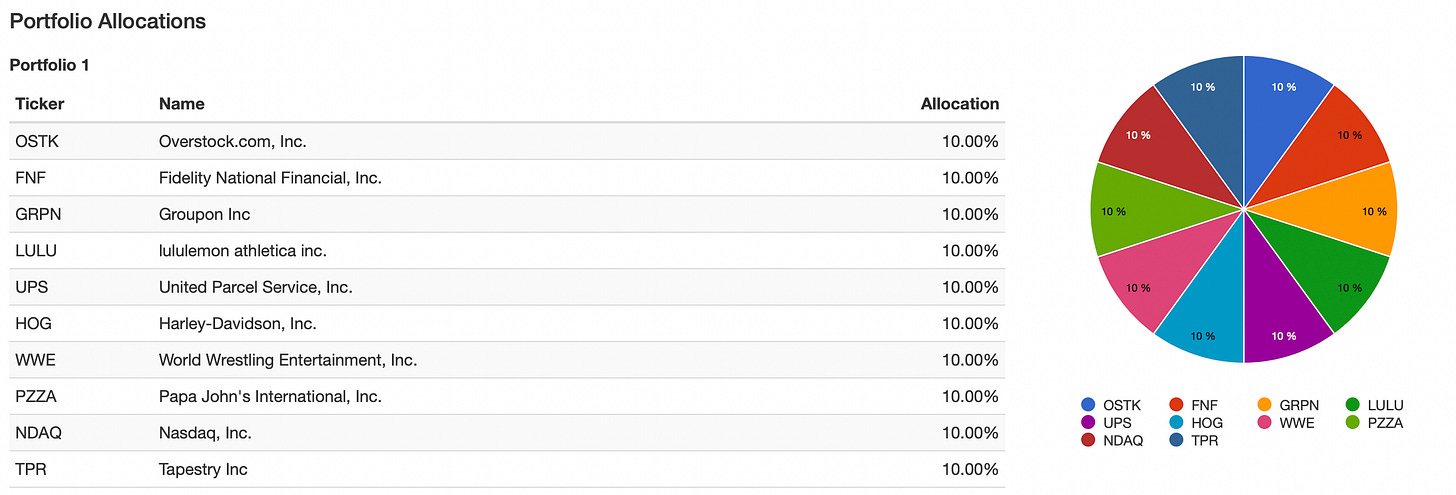Do Female Executives Make a Company's Stock Price go BRRR?
Welcome back everyone! Hope you all had a great week! This week I stumbled upon an investing thesis that is, well… less than strictly quantitative.
According to this article by CNBC female CEOs resulted in better average stock performance over the two years following their appointment.
This is not really a quantitative data measurement, although it did pique my interest. In the past we used traditional metrics like book valuations or price multiples, but what if we are overlooking something really simple along with everyone else?
This is not a completely unproven idea, after all there is a fund that pulls all equity investments out and puts them in cash and treasuries when Congress goes into session due to the government’s “destructive nature.” Or the Marketocracy Masters 100 Fund which picks it stocks through the most popular portfolios created by users on their website.
Reading about this got my gears turning, wondering if this is something we could use to our advantage. So, I decided to take a look at the S&P Global Report behind the article.
The report claims a few things:
The study finds that firms with female CFOs are more profitable and generated excess profits of $1.8T over the study horizon.
Firms with female CEOs and CFOs have produced superior stock price performance, compared to the market average. In the 24 months post-appointment, female CEOs
saw a 20% increase in stock price momentum and female CFOs saw a 6% increase in profitability and 8% larger stock returns. These results are economically and statistically significant.Firms with a high gender diversity on their board of directors were more profitable and larger than firms with low gender diversity.
Firms with female CEOs and CFOs have a demonstrated culture of Diversity and Inclusion (D&I), evinced by a larger representation of females on the company’s board of directors. Firms with female CEOs have twice the number of female board members, compared to the market average (23% vs 11%).
Analysis of executive biographies suggests that one driver of superior results by females may be that females are held to a higher standard. The average female executive has characteristics in common with the most successful male executives, suggesting that common attributes drive success among males and females, alike. Overall, the attributes that correlate with success among male executives were found more often in female executives. This finding refutes the commonly held belief in ‘token’ female executives.
So obviously, female executives have a noticeable and statistically significant effect on stock performance. However, it does depend on which executive position we are talking about. For the CEO role, there is not much data to show that there is any advantage to female management.
These returns are factor adjusted, meaning that we are accounting for size premiums, volatility, liquidity and other metrics when looking at the average return.
The female and male CEO stock performance here does not really differ much here. According to the study in order to be considered a “statistically significant difference” there would need to be a standard error in the data 7% further in either direction in order to meet the minimum threshold for statistical significance.
The results for CFOs paint a different picture…
The female CFOs being placed in the company is correlated with a very significant change in the performance of the company’s stock price. Over the three measured time periods (12 months, 24 months, and 36 months) the deviations between male and female exceed the threshold for statistical significance.
Although the threshold was lower for CFOs than CEOs, this mainly due to the sample size on which the study was conducted.
There was three times as many female CFOs as there were female CEOs (denoted by N=143 and N=435) allowing for a lower threshold for significance.
To explain this difference, the study posited that men and women overall were equally capable of successfully running a company as CEO and CFO, but that there is a gender bias against women in executive positions. Because of this bias the standards for women in executive positions are higher than the standards for men.
Essentially, while management would be willing to take a 50th percentile level executive if they were a man, the same would not be true for a woman. In order for a woman to take precedence over the man for the executive position, they would need to be in the 80th or 90th percentile of executives. Therefore, the results are skewed to show that women make better executives because the ones that are 50th percentile would never get a shot in the first place.
Regardless of ethics of this practice, for us as investors it is a good thing. More competent management never hurt anyone, and actually probably helps us more than anything.
So let’s put these claims to the test and look at the historical performance of companies with a female CFO change.
Because the time horizon for the study was short, we will keep with the precedent and only examine the following two years after a female CFO appointment. Our data comes from cfo.com showing the CFO turnover for year 2020.
These are ten of the companies with a female CFO in place.
Our performance numbers look very similar to the results described in the report.
The female CEO portfolio more than doubled the CAGR of an S&P 500 index fund. However, we do need to note that the Sharpe ratio of the female only portfolio was lower than that of the index fund. So while the return is higher, the risk also happens to be much higher to compensate.
This is only one datapoint though, so it might be worth looking at a second point.
Here is the list of companies that had a male appointed to the CFO position.
The returns seem to fall in line with the previous data, male CFO companies perform worse than female CFO companies.
In fact the performance deviation is very significant. These companies only had a 9.08% CAGR compared to the 23.62% CAGR of the companies with female CFOs. The Sharpe ratio is also noticeably worse than the overall market Sharpe ratio meaning not only were the returns worse than the benchmark, but so was the volatility.
Caveats To The Data:
As with all good things, there are a few caveats to this.
First, the backtests are very limited. The time frames are very short and only cover the last two years of stock performance. If I were to expand this section of the research I would not recommend increasing the holding time for the companies, but rather look at historical two year periods. This is because the report that we looked at only indicated that there was alpha for the first 1-3 years after the new CFO is appointed. I good method of backtesting this would be to start in some specific year and find the female CFO changes for that year, hold those companies for two years, and then repeat the process moving forward in time. (2000-2002, 2002-2004, 2004-2006, etc).
Second, the sample size is small. I would increase the amount of companies contained in our backtests to make it more comparable to the benchmark. With only 10 companies we might end up with a lack-of-diversification premium. To mitigate this I would increase the number of the companies looked in the backtests to 20-30. This is the minimum range that diversification starts to have diminishing effect on volatility and returns.
Lastly, I would check for sector bias. In order to compare the female and male CFO portfolios more evenly they would need to have a similar breakdown regarding the sectors contained in them.
Even with these caveats, I think that there might be something here worth investigating further. If you decide that you want to look into this further, or have any questions about my data, please don’t hesitate to leave a comment or email! I would love to hear your thoughts on the topic.
With that said, that is all I have for today’s post. If you enjoyed it and aren’t subscribed, please hit that little green button below! I only send one email a week so you are sure to have valuable (non-spam content) delivered to your email in a short digestible article every week.
And if you really enjoyed it, please consider referring a friend through my referral tool! You can win some cool swag by successfully referring a friend, and best of all, it only takes a few seconds!
All content is for discussion, entertainment, and illustrative purposes only and should not be construed as professional financial advice, solicitation, or recommendation to buy or sell any securities, notwithstanding anything stated.
There are risks associated with investing in securities. Loss of principal is possible. Some high-risk investments may use leverage, which could accentuate losses. Foreign investing involves special risks, including a greater volatility and political, economic and currency risks and differences in accounting methods. Past performance is not a predictor of future investment performance.
Should you need such advice, consult a licensed financial advisor, legal advisor, or tax advisor.
All views expressed are personal opinion and are subject to change without responsibility to update views. No guarantee is given regarding the accuracy of information on this post











